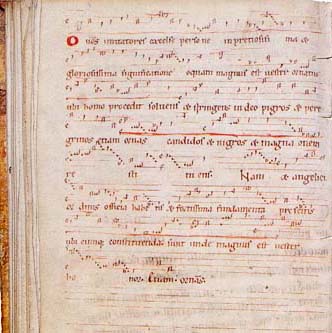Hildegard's Illuminations

Hildegard's Illuminations |
 |
Hildegard was born in 1098, the tenth and last child of apparently noble parents in Mainz. They offered her to God as tithe, acording to her biographer/secretary. Precarious health and a visionary gift were obvious from age three, when she experienced a "brightness so great that [her] soul trembled." She was able to tell the color of a calf still in the womb. In 1106 Hildegard became a companion of Jutta von Sponheim, a noblewoman who rejected offers of marriage in favor of the Benedictine cloister where she became anchoress, obliged to remain in her cell until death. The Benedictines taught elementary reading and singing in Latin; the primer was the Psalter. Hildegard continued her education with Volmer of Saint Disibod, a monk not much older than Hildegard -- a man who became her secretary and lifelong friend. In 1136 at Jutta's death, she became the replacement abbess at the double monastery.
Although she had been reluctant to acknowledge such experiences, in 1141 Hildegard had a blinding vision with a divine call to "tell and write." She began composing music in 1140s; Symphonia is the later cycle of collected works. She also wrote about her visions with Volmer as copy editor. Scivias (Scito vias Domini = know the ways of the Lord) is this collection of visions and exegesis, written through 1151.
Hildegard's morality play Ordo virtutum (Play of the Virtues), was later set to music and intended for performance by nuns. It may have been intended to celebrate the opening of Hildegard's convent, and could have been performed before or after a service. There's no borrowed chant here, but new composition with the highest register reserved for the rejoicing when the Devil in the drama is bound. The virtues are personified (chastity, humility, etc.) and vie with the Devil for the soul of a young girl. The Devil speaks or bellows his lines, indicating that he is not capable of music or that there is no music in Hell. The music often displays Hildegard's distinctive upward leap of the fifth, sometimes a brief step to the fifth on the way to a full octave.
Having visions could be a touchy political matter in the Middle Ages. In 1147 Hildegard sought the Church's endorsement and wrote to Bernard of Clairvaux for guidance. Bernard encouraged her and interceded on her behalf with Pope Eugenius III who also had heard of visions. Her fame grew and more postulants sought her out. A vision directed her to Rupertsberg near Bingen. The monastery there had been in ruins since the Norman destruction in 882. Initially there were objections within the monastery against Hildegard's going. She took to bed, and eventually this sudden illness was taken as God's displeasure at the delay. She moved in 1150 with twenty-some nuns. They got to wear tiaras inspired by one of her visions (emblems of blessed virgins in heaven).
In 1158-1160 Hildegard undertook four preaching journeys, each rather apocalyptic. The years 1158-1163 also saw the production of Liber vitae meritorum (The Book of Life's Merits): six visions and glosses. In the 1150s she wrote two volumes on natural science: Physica (tural History), a scientific and medical encyclopedia with herbal, bestiary, and lapidary inclusions; and Causae et curae (Causes and Cures), a handbook of physical and mental diseases and their cures with extensive material on sexuality. She also wrote Lingua ignota (Unknown Language), a glossary of nine hundred plus invented Germanic-sounding names for earthly and celestial beings, and Litterae ignotae (Unknown Writing) an alternative alphabet of 23 characters.
1163-1174 saw her third and final visionary trilogy volume, De operatione Dei (On the Activity of God; a.k.a. Liber divinorum operum, The Book of Divine Works), ten visions and commentaries on the prologue to the Gospel of John and Genesis 1. In 1173 Volmer died. A replacement, Godfrey, was sent by the Pope, and he began the vita of Hildegard but died in 1176 before finishing. Guibert then took over the duties.
In 1178 Hildegard's convent was placed under interdict: there was to be no Mass, no sacraments, no music. Their crime? They had buried an excommunicant. The interdict was lifted in March 1179. Hildegard died September 17th, 1179. In 1233 Pope Gregory IX began proceedings for canonization, but recorded materials were sloppy so the bid for sainthood foundered.
Emmerson, Richard K. "The Representation of Antichrist in Hildegard of Bingen's Scivias." Gesta 41.2 (2002): 95-110.
Hildegard von Bingen. 11,000 Virgins: Chants for the Feast of St. Ursula. CD. Perf. Anonymous 4. Harmonia Mundi / BMG Music, 1997. HMU 907200.
---. Canticles of Ecstasy. CD. Perf. Sequentia. Deutsche Harmonia Mundi / BMG Music, 1994. 05472 77320 2.
---. A Feather on the Breath of God: Sequences and Hymns. CD. Perf. Gothic Voices. London: Hyperion Records Ltd., 1984. CDA 66039.
---. The Harmony of Heaven. CD. Perf. Ellen Oak. Waldboro, ME: Bison Tales Pub., 1995. Bison Tales 0001.
---. Saints. 2 CDs. Perf. Sequentia. Deutsche Harmonia Mundi / BMG Music, 1998. 05472 77378 2.
---. Symphoniae. CD. Perf. Sequentia. Cologne: Harmonia Mundi / BMG Music, 1985. 77020-2-RG.
---. Voice of the Blood. CD. Perf. Sequentia. Deutsche Harmonia Mundi / BMG Music, 1995. 05472 77346 2.
Illuminations of Hildegard of Bingen. Ed. Matthew Fox. Santa Fe, NM: Bear and Co., 1985.
Vision: The Music of Hildegard von Bingen. CD. Angel, 1994. CDC 7243 5 55246 2 1.